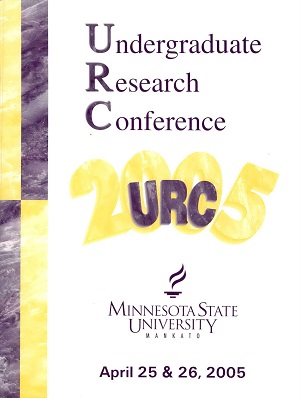Quantification of Malondialdehyde in Exercise Participants
Location
CSU 253
Start Date
26-4-2005 10:00 AM
End Date
26-4-2005 12:00 PM
Student's Major
Chemistry and Geology
Student's College
Science, Engineering and Technology
Mentor's Name
Mary Hadley
Mentor's Department
Chemistry and Geology
Mentor's College
Science, Engineering and Technology
Second Mentor's Name
Mary Visser
Second Mentor's Department
Human Performance
Second Mentor's College
Allied Health and Nursing
Description
Malondialdehyde (MDA) is a byproduct of lipid peroxidation (LP) and its production in vivo should increase with exercise. Increased LP has been correlated with increased incidences of adverse physiological conditions such as heart disease. It may be beneficial for those who exercise regularly to increase their intake of the antioxidant vitamin E to decrease LP. This pilot experiment was conducted to determine if supplementation of vitamin E would decrease urinary MDA excretion in non-athletes who participate in a prescribed exercise regiment (IRB log 1973 ). Urine and dietary diet records were collected from the subjects, some received a daily vitamin E supplement. The urine was treated with thiobarbituric acid (TEA) and the resulting TBA-MDA complex was quantified using a high pressure liquid chromatography system. Although the number of subjects volunteering for this experiment was too small for any conclusions to be drawn, it appears that the subjects who received the vitamin E had reduced levels of MDA after 8 weeks of supplementation. To reach any conclusion the experiment must be repeated with more subjects.
Quantification of Malondialdehyde in Exercise Participants
CSU 253
Malondialdehyde (MDA) is a byproduct of lipid peroxidation (LP) and its production in vivo should increase with exercise. Increased LP has been correlated with increased incidences of adverse physiological conditions such as heart disease. It may be beneficial for those who exercise regularly to increase their intake of the antioxidant vitamin E to decrease LP. This pilot experiment was conducted to determine if supplementation of vitamin E would decrease urinary MDA excretion in non-athletes who participate in a prescribed exercise regiment (IRB log 1973 ). Urine and dietary diet records were collected from the subjects, some received a daily vitamin E supplement. The urine was treated with thiobarbituric acid (TEA) and the resulting TBA-MDA complex was quantified using a high pressure liquid chromatography system. Although the number of subjects volunteering for this experiment was too small for any conclusions to be drawn, it appears that the subjects who received the vitamin E had reduced levels of MDA after 8 weeks of supplementation. To reach any conclusion the experiment must be repeated with more subjects.




